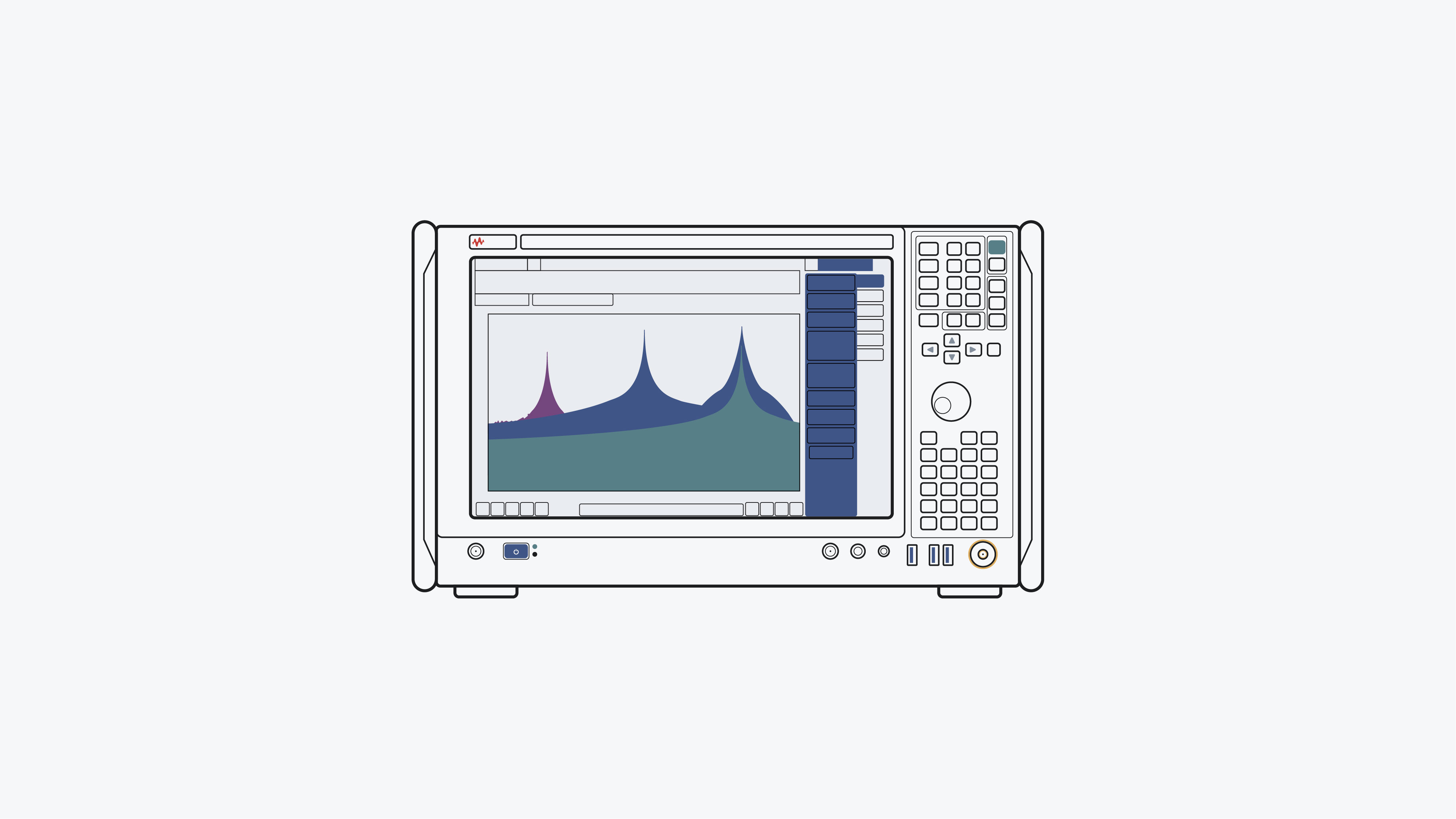How to Improve Power Amplifier Linearity


Using digital pre-distortion to improve power amplifier efficiency
Improving power amplifier (PA) linearity and efficiency requires a linearization technique called digital pre-distortion (DPD). The DPD technique adds expanding non-linearity to the baseband that complements the compressing characteristic of the RF PA. Ideally, the pre-distorter and the PA cascade become linear, and a constant gain amplifies the original input. With the pre-distorter, you can use a PA up to its saturation point while still maintaining good linearity to increase efficiency.
The DPD method uses a signal generator to generate pre-distorted waveforms and a signal analyzer to extract the DPD model. The signal analyzer then transfers model parameters, such as the lookup table (LUT) or coefficients, to the signal generator. The signal generator applies pre-distortion to the waveform. Then, the waveform plays back to the device under test (DUT) PA. This approach helps improve the adjacent channel power ratio and error vector magnitude to appear closer to linear operation.

Power amplifier DPD measurement solution
See demo of a DPD measurement on a PA
Explore products in our power amplifier DPD measurement solution
-
![N9042B UXA Signal Analyzer, 2 Hz to 75 GHz]()
N9042B UXA Signal Analyzer, 2 Hz to 75 GHz
-
![M9484C VXG Vector Signal Generator]()
M9484C VXG Vector Signal Generator
-
![N9055EM0E Power Amplifier Measurement Application, Multi-Touch UI]()
N9055EM0E Power Amplifier Measurement Application, Multi-Touch UI


How to Improve Power Amplifier Linearity
N9042B UXA Signal Analyzer, 2 Hz to 75 GHz
Solve tomorrow's millimeter-wave challenges today
Specs
| Frequency | 75 GHz |
| DANL @1 GHz | -168 dBm |
| Maximum Analysis Bandwidth | 4 GHz |
| Maximum Real Time Bandwidth | 2 GHz |
| Phase Noise @1 GHz (10 kHz offset) | -135 dBc/Hz |
| Type |
|


How to Improve Power Amplifier Linearity
M9484C VXG Vector Signal Generator
The M9484C VXG is the vector signal generator capable of generating signals up to 54 GHz with 2.5 GHz of modulation bandwidth per channel. The VXG vector signal generator helps you deliver the next frontier of wireless technology such as 5G and satellite communications with a fully integrated, calibrated, and synchronized solution.
Specs
| Frequency | 54 GHz |
| Output Power @1 GHz | +20 dBm |
| Frequency switching speed | 3 ms |
| Harmonics @1 GHz | -55 dBc |
| Phase Noise @1 GHz (20 kHz offset) | -148 dBc/Hz |
| Type |
|


How to Improve Power Amplifier Linearity
N9055EM0E Power Amplifier Measurement Application, Multi-Touch UI
Power amplifier with predistortion in RF/millimeter wave
Specs
| License Types |
|
| Software Type |
|
| Industry Segment |
|
| Technology |
|
Discover resources and insights
Additional resources for power amplifier DPD measurement
-
Application note
Make Successful PA DPD Measurements Using our PA Measurement Application
-
Technical overview
Discover the Key Features of the PA Measurement Application
-
Datasheet
Read the UXA X-Series Signal Analyzer, Multi-Touch Datasheet
-
Application Note
Learn About Iterative Learning Control Digital Pre-distortion
-
Application note
Make Successful PA DPD Measurements Using our PA Measurement Application
-
Technical overview
Discover the Key Features of the PA Measurement Application
-
Datasheet
Read the UXA X-Series Signal Analyzer, Multi-Touch Datasheet
-
Application Note
Learn About Iterative Learning Control Digital Pre-distortion
Related use cases
-
![How to Test a Satellite Transceiver with DVB-S2X Signals]() keysight:dtx/solutions/facets/development-area/rf,keysight:dtx/solutions/facets/design-and-test-product/signal-analyzer,keysight:dtx/solutions/facets/industry/aerospace-and-defense,segmentation:business-unit/CSG,segmentation:campaign/Aerospace_Defense,segmentation:product-category/RF_Testing,segmentation:funnel/mofu,keysight:dtx/solutions/facets/workflow-stage/functional-test,segmentation:product-category/RF_Testing/Signal_Analyzers,keysight:product-lines/12keysight:dtx/solutions/facets/development-area/rf,keysight:dtx/solutions/facets/design-and-test-product/signal-analyzer,keysight:dtx/solutions/facets/industry/aerospace-and-defense,segmentation:business-unit/CSG,segmentation:campaign/Aerospace_Defense,segmentation:product-category/RF_Testing,segmentation:funnel/mofu,keysight:dtx/solutions/facets/workflow-stage/functional-test,segmentation:product-category/RF_Testing/Signal_Analyzers,keysight:product-lines/12keysight:dtx/solutions/facets/development-area/rf,keysight:dtx/solutions/facets/design-and-test-product/signal-analyzer,keysight:dtx/solutions/facets/industry/aerospace-and-defense,segmentation:business-unit/CSG,segmentation:campaign/Aerospace_Defense,segmentation:product-category/RF_Testing,segmentation:funnel/mofu,keysight:dtx/solutions/facets/workflow-stage/functional-test,segmentation:product-category/RF_Testing/Signal_Analyzers,keysight:product-lines/12keysight:dtx/solutions/facets/development-area/rf,keysight:dtx/solutions/facets/design-and-test-product/signal-analyzer,keysight:dtx/solutions/facets/industry/aerospace-and-defense,segmentation:business-unit/CSG,segmentation:campaign/Aerospace_Defense,segmentation:product-category/RF_Testing,segmentation:funnel/mofu,keysight:dtx/solutions/facets/workflow-stage/functional-test,segmentation:product-category/RF_Testing/Signal_Analyzers,keysight:product-lines/12keysight:dtx/solutions/facets/development-area/rf,keysight:dtx/solutions/facets/design-and-test-product/signal-analyzer,keysight:dtx/solutions/facets/industry/aerospace-and-defense,segmentation:business-unit/CSG,segmentation:campaign/Aerospace_Defense,segmentation:product-category/RF_Testing,segmentation:funnel/mofu,keysight:dtx/solutions/facets/workflow-stage/functional-test,segmentation:product-category/RF_Testing/Signal_Analyzers,keysight:product-lines/12keysight:dtx/solutions/facets/development-area/rf,keysight:dtx/solutions/facets/design-and-test-product/signal-analyzer,keysight:dtx/solutions/facets/industry/aerospace-and-defense,segmentation:business-unit/CSG,segmentation:campaign/Aerospace_Defense,segmentation:product-category/RF_Testing,segmentation:funnel/mofu,keysight:dtx/solutions/facets/workflow-stage/functional-test,segmentation:product-category/RF_Testing/Signal_Analyzers,keysight:product-lines/12keysight:dtx/solutions/facets/development-area/rf,keysight:dtx/solutions/facets/design-and-test-product/signal-analyzer,keysight:dtx/solutions/facets/industry/aerospace-and-defense,segmentation:business-unit/CSG,segmentation:campaign/Aerospace_Defense,segmentation:product-category/RF_Testing,segmentation:funnel/mofu,keysight:dtx/solutions/facets/workflow-stage/functional-test,segmentation:product-category/RF_Testing/Signal_Analyzers,keysight:product-lines/12keysight:dtx/solutions/facets/development-area/rf,keysight:dtx/solutions/facets/design-and-test-product/signal-analyzer,keysight:dtx/solutions/facets/industry/aerospace-and-defense,segmentation:business-unit/CSG,segmentation:campaign/Aerospace_Defense,segmentation:product-category/RF_Testing,segmentation:funnel/mofu,keysight:dtx/solutions/facets/workflow-stage/functional-test,segmentation:product-category/RF_Testing/Signal_Analyzers,keysight:product-lines/12keysight:dtx/solutions/facets/development-area/rf,keysight:dtx/solutions/facets/design-and-test-product/signal-analyzer,keysight:dtx/solutions/facets/industry/aerospace-and-defense,segmentation:business-unit/CSG,segmentation:campaign/Aerospace_Defense,segmentation:product-category/RF_Testing,segmentation:funnel/mofu,keysight:dtx/solutions/facets/workflow-stage/functional-test,segmentation:product-category/RF_Testing/Signal_Analyzers,keysight:product-lines/12keysight:dtx/solutions/facets/development-area/rf,keysight:dtx/solutions/facets/design-and-test-product/signal-analyzer,keysight:dtx/solutions/facets/industry/aerospace-and-defense,segmentation:business-unit/CSG,segmentation:campaign/Aerospace_Defense,segmentation:product-category/RF_Testing,segmentation:funnel/mofu,keysight:dtx/solutions/facets/workflow-stage/functional-test,segmentation:product-category/RF_Testing/Signal_Analyzers,keysight:product-lines/12
keysight:dtx/solutions/facets/development-area/rf,keysight:dtx/solutions/facets/design-and-test-product/signal-analyzer,keysight:dtx/solutions/facets/industry/aerospace-and-defense,segmentation:business-unit/CSG,segmentation:campaign/Aerospace_Defense,segmentation:product-category/RF_Testing,segmentation:funnel/mofu,keysight:dtx/solutions/facets/workflow-stage/functional-test,segmentation:product-category/RF_Testing/Signal_Analyzers,keysight:product-lines/12keysight:dtx/solutions/facets/development-area/rf,keysight:dtx/solutions/facets/design-and-test-product/signal-analyzer,keysight:dtx/solutions/facets/industry/aerospace-and-defense,segmentation:business-unit/CSG,segmentation:campaign/Aerospace_Defense,segmentation:product-category/RF_Testing,segmentation:funnel/mofu,keysight:dtx/solutions/facets/workflow-stage/functional-test,segmentation:product-category/RF_Testing/Signal_Analyzers,keysight:product-lines/12keysight:dtx/solutions/facets/development-area/rf,keysight:dtx/solutions/facets/design-and-test-product/signal-analyzer,keysight:dtx/solutions/facets/industry/aerospace-and-defense,segmentation:business-unit/CSG,segmentation:campaign/Aerospace_Defense,segmentation:product-category/RF_Testing,segmentation:funnel/mofu,keysight:dtx/solutions/facets/workflow-stage/functional-test,segmentation:product-category/RF_Testing/Signal_Analyzers,keysight:product-lines/12keysight:dtx/solutions/facets/development-area/rf,keysight:dtx/solutions/facets/design-and-test-product/signal-analyzer,keysight:dtx/solutions/facets/industry/aerospace-and-defense,segmentation:business-unit/CSG,segmentation:campaign/Aerospace_Defense,segmentation:product-category/RF_Testing,segmentation:funnel/mofu,keysight:dtx/solutions/facets/workflow-stage/functional-test,segmentation:product-category/RF_Testing/Signal_Analyzers,keysight:product-lines/12keysight:dtx/solutions/facets/development-area/rf,keysight:dtx/solutions/facets/design-and-test-product/signal-analyzer,keysight:dtx/solutions/facets/industry/aerospace-and-defense,segmentation:business-unit/CSG,segmentation:campaign/Aerospace_Defense,segmentation:product-category/RF_Testing,segmentation:funnel/mofu,keysight:dtx/solutions/facets/workflow-stage/functional-test,segmentation:product-category/RF_Testing/Signal_Analyzers,keysight:product-lines/12keysight:dtx/solutions/facets/development-area/rf,keysight:dtx/solutions/facets/design-and-test-product/signal-analyzer,keysight:dtx/solutions/facets/industry/aerospace-and-defense,segmentation:business-unit/CSG,segmentation:campaign/Aerospace_Defense,segmentation:product-category/RF_Testing,segmentation:funnel/mofu,keysight:dtx/solutions/facets/workflow-stage/functional-test,segmentation:product-category/RF_Testing/Signal_Analyzers,keysight:product-lines/12keysight:dtx/solutions/facets/development-area/rf,keysight:dtx/solutions/facets/design-and-test-product/signal-analyzer,keysight:dtx/solutions/facets/industry/aerospace-and-defense,segmentation:business-unit/CSG,segmentation:campaign/Aerospace_Defense,segmentation:product-category/RF_Testing,segmentation:funnel/mofu,keysight:dtx/solutions/facets/workflow-stage/functional-test,segmentation:product-category/RF_Testing/Signal_Analyzers,keysight:product-lines/12keysight:dtx/solutions/facets/development-area/rf,keysight:dtx/solutions/facets/design-and-test-product/signal-analyzer,keysight:dtx/solutions/facets/industry/aerospace-and-defense,segmentation:business-unit/CSG,segmentation:campaign/Aerospace_Defense,segmentation:product-category/RF_Testing,segmentation:funnel/mofu,keysight:dtx/solutions/facets/workflow-stage/functional-test,segmentation:product-category/RF_Testing/Signal_Analyzers,keysight:product-lines/12keysight:dtx/solutions/facets/development-area/rf,keysight:dtx/solutions/facets/design-and-test-product/signal-analyzer,keysight:dtx/solutions/facets/industry/aerospace-and-defense,segmentation:business-unit/CSG,segmentation:campaign/Aerospace_Defense,segmentation:product-category/RF_Testing,segmentation:funnel/mofu,keysight:dtx/solutions/facets/workflow-stage/functional-test,segmentation:product-category/RF_Testing/Signal_Analyzers,keysight:product-lines/12keysight:dtx/solutions/facets/development-area/rf,keysight:dtx/solutions/facets/design-and-test-product/signal-analyzer,keysight:dtx/solutions/facets/industry/aerospace-and-defense,segmentation:business-unit/CSG,segmentation:campaign/Aerospace_Defense,segmentation:product-category/RF_Testing,segmentation:funnel/mofu,keysight:dtx/solutions/facets/workflow-stage/functional-test,segmentation:product-category/RF_Testing/Signal_Analyzers,keysight:product-lines/12How to Test a Satellite Transceiver with DVB-S2X Signals
Testing satellite transceivers with DVB-S2X signals for conformance and interoperability requires signal analysis under real-world conditions. Learn how to use signal creation and analysis to test your satellite transceiver.
Learn more

-
![How to Test Satellite Receivers for Wideband Interfering Signals]() keysight:hierarchy/industries/aerospace-defense/space-and-satellite,keysight:dtx/solutions/facets/development-area/rf,keysight:dtx/solutions/facets/design-and-test-product/signal-analyzer,keysight:dtx/solutions/facets/workflow-stage/functional-test,keysight:dtx/solutions/facets/industry/aerospace-and-defense,segmentation:campaign/RF,segmentation:product-category/RF_Testing,segmentation:product-category/RF_Testing/Signal_Analyzers,segmentation:business-unit/CSG,keysight:product-lines/12,segmentation:funnel/tofukeysight:hierarchy/industries/aerospace-defense/space-and-satellite,keysight:dtx/solutions/facets/development-area/rf,keysight:dtx/solutions/facets/design-and-test-product/signal-analyzer,keysight:dtx/solutions/facets/workflow-stage/functional-test,keysight:dtx/solutions/facets/industry/aerospace-and-defense,segmentation:campaign/RF,segmentation:product-category/RF_Testing,segmentation:product-category/RF_Testing/Signal_Analyzers,segmentation:business-unit/CSG,keysight:product-lines/12,segmentation:funnel/tofukeysight:hierarchy/industries/aerospace-defense/space-and-satellite,keysight:dtx/solutions/facets/development-area/rf,keysight:dtx/solutions/facets/design-and-test-product/signal-analyzer,keysight:dtx/solutions/facets/workflow-stage/functional-test,keysight:dtx/solutions/facets/industry/aerospace-and-defense,segmentation:campaign/RF,segmentation:product-category/RF_Testing,segmentation:product-category/RF_Testing/Signal_Analyzers,segmentation:business-unit/CSG,keysight:product-lines/12,segmentation:funnel/tofukeysight:hierarchy/industries/aerospace-defense/space-and-satellite,keysight:dtx/solutions/facets/development-area/rf,keysight:dtx/solutions/facets/design-and-test-product/signal-analyzer,keysight:dtx/solutions/facets/workflow-stage/functional-test,keysight:dtx/solutions/facets/industry/aerospace-and-defense,segmentation:campaign/RF,segmentation:product-category/RF_Testing,segmentation:product-category/RF_Testing/Signal_Analyzers,segmentation:business-unit/CSG,keysight:product-lines/12,segmentation:funnel/tofukeysight:hierarchy/industries/aerospace-defense/space-and-satellite,keysight:dtx/solutions/facets/development-area/rf,keysight:dtx/solutions/facets/design-and-test-product/signal-analyzer,keysight:dtx/solutions/facets/workflow-stage/functional-test,keysight:dtx/solutions/facets/industry/aerospace-and-defense,segmentation:campaign/RF,segmentation:product-category/RF_Testing,segmentation:product-category/RF_Testing/Signal_Analyzers,segmentation:business-unit/CSG,keysight:product-lines/12,segmentation:funnel/tofukeysight:hierarchy/industries/aerospace-defense/space-and-satellite,keysight:dtx/solutions/facets/development-area/rf,keysight:dtx/solutions/facets/design-and-test-product/signal-analyzer,keysight:dtx/solutions/facets/workflow-stage/functional-test,keysight:dtx/solutions/facets/industry/aerospace-and-defense,segmentation:campaign/RF,segmentation:product-category/RF_Testing,segmentation:product-category/RF_Testing/Signal_Analyzers,segmentation:business-unit/CSG,keysight:product-lines/12,segmentation:funnel/tofukeysight:hierarchy/industries/aerospace-defense/space-and-satellite,keysight:dtx/solutions/facets/development-area/rf,keysight:dtx/solutions/facets/design-and-test-product/signal-analyzer,keysight:dtx/solutions/facets/workflow-stage/functional-test,keysight:dtx/solutions/facets/industry/aerospace-and-defense,segmentation:campaign/RF,segmentation:product-category/RF_Testing,segmentation:product-category/RF_Testing/Signal_Analyzers,segmentation:business-unit/CSG,keysight:product-lines/12,segmentation:funnel/tofukeysight:hierarchy/industries/aerospace-defense/space-and-satellite,keysight:dtx/solutions/facets/development-area/rf,keysight:dtx/solutions/facets/design-and-test-product/signal-analyzer,keysight:dtx/solutions/facets/workflow-stage/functional-test,keysight:dtx/solutions/facets/industry/aerospace-and-defense,segmentation:campaign/RF,segmentation:product-category/RF_Testing,segmentation:product-category/RF_Testing/Signal_Analyzers,segmentation:business-unit/CSG,keysight:product-lines/12,segmentation:funnel/tofukeysight:hierarchy/industries/aerospace-defense/space-and-satellite,keysight:dtx/solutions/facets/development-area/rf,keysight:dtx/solutions/facets/design-and-test-product/signal-analyzer,keysight:dtx/solutions/facets/workflow-stage/functional-test,keysight:dtx/solutions/facets/industry/aerospace-and-defense,segmentation:campaign/RF,segmentation:product-category/RF_Testing,segmentation:product-category/RF_Testing/Signal_Analyzers,segmentation:business-unit/CSG,keysight:product-lines/12,segmentation:funnel/tofukeysight:hierarchy/industries/aerospace-defense/space-and-satellite,keysight:dtx/solutions/facets/development-area/rf,keysight:dtx/solutions/facets/design-and-test-product/signal-analyzer,keysight:dtx/solutions/facets/workflow-stage/functional-test,keysight:dtx/solutions/facets/industry/aerospace-and-defense,segmentation:campaign/RF,segmentation:product-category/RF_Testing,segmentation:product-category/RF_Testing/Signal_Analyzers,segmentation:business-unit/CSG,keysight:product-lines/12,segmentation:funnel/tofukeysight:hierarchy/industries/aerospace-defense/space-and-satellite,keysight:dtx/solutions/facets/development-area/rf,keysight:dtx/solutions/facets/design-and-test-product/signal-analyzer,keysight:dtx/solutions/facets/workflow-stage/functional-test,keysight:dtx/solutions/facets/industry/aerospace-and-defense,segmentation:campaign/RF,segmentation:product-category/RF_Testing,segmentation:product-category/RF_Testing/Signal_Analyzers,segmentation:business-unit/CSG,keysight:product-lines/12,segmentation:funnel/tofu
keysight:hierarchy/industries/aerospace-defense/space-and-satellite,keysight:dtx/solutions/facets/development-area/rf,keysight:dtx/solutions/facets/design-and-test-product/signal-analyzer,keysight:dtx/solutions/facets/workflow-stage/functional-test,keysight:dtx/solutions/facets/industry/aerospace-and-defense,segmentation:campaign/RF,segmentation:product-category/RF_Testing,segmentation:product-category/RF_Testing/Signal_Analyzers,segmentation:business-unit/CSG,keysight:product-lines/12,segmentation:funnel/tofukeysight:hierarchy/industries/aerospace-defense/space-and-satellite,keysight:dtx/solutions/facets/development-area/rf,keysight:dtx/solutions/facets/design-and-test-product/signal-analyzer,keysight:dtx/solutions/facets/workflow-stage/functional-test,keysight:dtx/solutions/facets/industry/aerospace-and-defense,segmentation:campaign/RF,segmentation:product-category/RF_Testing,segmentation:product-category/RF_Testing/Signal_Analyzers,segmentation:business-unit/CSG,keysight:product-lines/12,segmentation:funnel/tofukeysight:hierarchy/industries/aerospace-defense/space-and-satellite,keysight:dtx/solutions/facets/development-area/rf,keysight:dtx/solutions/facets/design-and-test-product/signal-analyzer,keysight:dtx/solutions/facets/workflow-stage/functional-test,keysight:dtx/solutions/facets/industry/aerospace-and-defense,segmentation:campaign/RF,segmentation:product-category/RF_Testing,segmentation:product-category/RF_Testing/Signal_Analyzers,segmentation:business-unit/CSG,keysight:product-lines/12,segmentation:funnel/tofukeysight:hierarchy/industries/aerospace-defense/space-and-satellite,keysight:dtx/solutions/facets/development-area/rf,keysight:dtx/solutions/facets/design-and-test-product/signal-analyzer,keysight:dtx/solutions/facets/workflow-stage/functional-test,keysight:dtx/solutions/facets/industry/aerospace-and-defense,segmentation:campaign/RF,segmentation:product-category/RF_Testing,segmentation:product-category/RF_Testing/Signal_Analyzers,segmentation:business-unit/CSG,keysight:product-lines/12,segmentation:funnel/tofukeysight:hierarchy/industries/aerospace-defense/space-and-satellite,keysight:dtx/solutions/facets/development-area/rf,keysight:dtx/solutions/facets/design-and-test-product/signal-analyzer,keysight:dtx/solutions/facets/workflow-stage/functional-test,keysight:dtx/solutions/facets/industry/aerospace-and-defense,segmentation:campaign/RF,segmentation:product-category/RF_Testing,segmentation:product-category/RF_Testing/Signal_Analyzers,segmentation:business-unit/CSG,keysight:product-lines/12,segmentation:funnel/tofukeysight:hierarchy/industries/aerospace-defense/space-and-satellite,keysight:dtx/solutions/facets/development-area/rf,keysight:dtx/solutions/facets/design-and-test-product/signal-analyzer,keysight:dtx/solutions/facets/workflow-stage/functional-test,keysight:dtx/solutions/facets/industry/aerospace-and-defense,segmentation:campaign/RF,segmentation:product-category/RF_Testing,segmentation:product-category/RF_Testing/Signal_Analyzers,segmentation:business-unit/CSG,keysight:product-lines/12,segmentation:funnel/tofukeysight:hierarchy/industries/aerospace-defense/space-and-satellite,keysight:dtx/solutions/facets/development-area/rf,keysight:dtx/solutions/facets/design-and-test-product/signal-analyzer,keysight:dtx/solutions/facets/workflow-stage/functional-test,keysight:dtx/solutions/facets/industry/aerospace-and-defense,segmentation:campaign/RF,segmentation:product-category/RF_Testing,segmentation:product-category/RF_Testing/Signal_Analyzers,segmentation:business-unit/CSG,keysight:product-lines/12,segmentation:funnel/tofukeysight:hierarchy/industries/aerospace-defense/space-and-satellite,keysight:dtx/solutions/facets/development-area/rf,keysight:dtx/solutions/facets/design-and-test-product/signal-analyzer,keysight:dtx/solutions/facets/workflow-stage/functional-test,keysight:dtx/solutions/facets/industry/aerospace-and-defense,segmentation:campaign/RF,segmentation:product-category/RF_Testing,segmentation:product-category/RF_Testing/Signal_Analyzers,segmentation:business-unit/CSG,keysight:product-lines/12,segmentation:funnel/tofukeysight:hierarchy/industries/aerospace-defense/space-and-satellite,keysight:dtx/solutions/facets/development-area/rf,keysight:dtx/solutions/facets/design-and-test-product/signal-analyzer,keysight:dtx/solutions/facets/workflow-stage/functional-test,keysight:dtx/solutions/facets/industry/aerospace-and-defense,segmentation:campaign/RF,segmentation:product-category/RF_Testing,segmentation:product-category/RF_Testing/Signal_Analyzers,segmentation:business-unit/CSG,keysight:product-lines/12,segmentation:funnel/tofukeysight:hierarchy/industries/aerospace-defense/space-and-satellite,keysight:dtx/solutions/facets/development-area/rf,keysight:dtx/solutions/facets/design-and-test-product/signal-analyzer,keysight:dtx/solutions/facets/workflow-stage/functional-test,keysight:dtx/solutions/facets/industry/aerospace-and-defense,segmentation:campaign/RF,segmentation:product-category/RF_Testing,segmentation:product-category/RF_Testing/Signal_Analyzers,segmentation:business-unit/CSG,keysight:product-lines/12,segmentation:funnel/tofukeysight:hierarchy/industries/aerospace-defense/space-and-satellite,keysight:dtx/solutions/facets/development-area/rf,keysight:dtx/solutions/facets/design-and-test-product/signal-analyzer,keysight:dtx/solutions/facets/workflow-stage/functional-test,keysight:dtx/solutions/facets/industry/aerospace-and-defense,segmentation:campaign/RF,segmentation:product-category/RF_Testing,segmentation:product-category/RF_Testing/Signal_Analyzers,segmentation:business-unit/CSG,keysight:product-lines/12,segmentation:funnel/tofuHow to Test Satellite Receivers for Wideband Interfering Signals
Monitoring and detecting wideband interfering signals in satellite receivers, requires a signal analyzer capable of performing wideband real-time spectrum analysis (RTSA) to ensure even short-duration signals are captured. Learn how to measure wideband RTSA and provide gapless analysis bandwidths to see, capture, and understand the most elusive signals, even with a very low probability of intercept.
Learn more

-
![How to Characterize the Signal Quality of a Transmission Channel]() keysight:hierarchy/industries/aerospace-defense/space-and-satellite,segmentation:campaign/Aerospace_Defense,keysight:hierarchy/products/modular/reference-solutions/satellite-signal-monitoring-reference-solution,keysight:hierarchy/products/application-specific-test-systems/aerospace-and-defense-ate-systems-and-services,keysight:dtx/solutions/facets/development-area/rf,keysight:dtx/solutions/facets/design-and-test-product/signal-analyzer,keysight:dtx/solutions/facets/workflow-stage/functional-test,keysight:dtx/solutions/facets/industry/aerospace-and-defense,segmentation:product-category/RF_Testing,segmentation:product-category/RF_Testing/Signal_Analyzers,segmentation:business-unit/CSG,keysight:product-lines/12,segmentation:funnel/tofukeysight:hierarchy/industries/aerospace-defense/space-and-satellite,segmentation:campaign/Aerospace_Defense,keysight:hierarchy/products/modular/reference-solutions/satellite-signal-monitoring-reference-solution,keysight:hierarchy/products/application-specific-test-systems/aerospace-and-defense-ate-systems-and-services,keysight:dtx/solutions/facets/development-area/rf,keysight:dtx/solutions/facets/design-and-test-product/signal-analyzer,keysight:dtx/solutions/facets/workflow-stage/functional-test,keysight:dtx/solutions/facets/industry/aerospace-and-defense,segmentation:product-category/RF_Testing,segmentation:product-category/RF_Testing/Signal_Analyzers,segmentation:business-unit/CSG,keysight:product-lines/12,segmentation:funnel/tofukeysight:hierarchy/industries/aerospace-defense/space-and-satellite,segmentation:campaign/Aerospace_Defense,keysight:hierarchy/products/modular/reference-solutions/satellite-signal-monitoring-reference-solution,keysight:hierarchy/products/application-specific-test-systems/aerospace-and-defense-ate-systems-and-services,keysight:dtx/solutions/facets/development-area/rf,keysight:dtx/solutions/facets/design-and-test-product/signal-analyzer,keysight:dtx/solutions/facets/workflow-stage/functional-test,keysight:dtx/solutions/facets/industry/aerospace-and-defense,segmentation:product-category/RF_Testing,segmentation:product-category/RF_Testing/Signal_Analyzers,segmentation:business-unit/CSG,keysight:product-lines/12,segmentation:funnel/tofukeysight:hierarchy/industries/aerospace-defense/space-and-satellite,segmentation:campaign/Aerospace_Defense,keysight:hierarchy/products/modular/reference-solutions/satellite-signal-monitoring-reference-solution,keysight:hierarchy/products/application-specific-test-systems/aerospace-and-defense-ate-systems-and-services,keysight:dtx/solutions/facets/development-area/rf,keysight:dtx/solutions/facets/design-and-test-product/signal-analyzer,keysight:dtx/solutions/facets/workflow-stage/functional-test,keysight:dtx/solutions/facets/industry/aerospace-and-defense,segmentation:product-category/RF_Testing,segmentation:product-category/RF_Testing/Signal_Analyzers,segmentation:business-unit/CSG,keysight:product-lines/12,segmentation:funnel/tofukeysight:hierarchy/industries/aerospace-defense/space-and-satellite,segmentation:campaign/Aerospace_Defense,keysight:hierarchy/products/modular/reference-solutions/satellite-signal-monitoring-reference-solution,keysight:hierarchy/products/application-specific-test-systems/aerospace-and-defense-ate-systems-and-services,keysight:dtx/solutions/facets/development-area/rf,keysight:dtx/solutions/facets/design-and-test-product/signal-analyzer,keysight:dtx/solutions/facets/workflow-stage/functional-test,keysight:dtx/solutions/facets/industry/aerospace-and-defense,segmentation:product-category/RF_Testing,segmentation:product-category/RF_Testing/Signal_Analyzers,segmentation:business-unit/CSG,keysight:product-lines/12,segmentation:funnel/tofukeysight:hierarchy/industries/aerospace-defense/space-and-satellite,segmentation:campaign/Aerospace_Defense,keysight:hierarchy/products/modular/reference-solutions/satellite-signal-monitoring-reference-solution,keysight:hierarchy/products/application-specific-test-systems/aerospace-and-defense-ate-systems-and-services,keysight:dtx/solutions/facets/development-area/rf,keysight:dtx/solutions/facets/design-and-test-product/signal-analyzer,keysight:dtx/solutions/facets/workflow-stage/functional-test,keysight:dtx/solutions/facets/industry/aerospace-and-defense,segmentation:product-category/RF_Testing,segmentation:product-category/RF_Testing/Signal_Analyzers,segmentation:business-unit/CSG,keysight:product-lines/12,segmentation:funnel/tofukeysight:hierarchy/industries/aerospace-defense/space-and-satellite,segmentation:campaign/Aerospace_Defense,keysight:hierarchy/products/modular/reference-solutions/satellite-signal-monitoring-reference-solution,keysight:hierarchy/products/application-specific-test-systems/aerospace-and-defense-ate-systems-and-services,keysight:dtx/solutions/facets/development-area/rf,keysight:dtx/solutions/facets/design-and-test-product/signal-analyzer,keysight:dtx/solutions/facets/workflow-stage/functional-test,keysight:dtx/solutions/facets/industry/aerospace-and-defense,segmentation:product-category/RF_Testing,segmentation:product-category/RF_Testing/Signal_Analyzers,segmentation:business-unit/CSG,keysight:product-lines/12,segmentation:funnel/tofukeysight:hierarchy/industries/aerospace-defense/space-and-satellite,segmentation:campaign/Aerospace_Defense,keysight:hierarchy/products/modular/reference-solutions/satellite-signal-monitoring-reference-solution,keysight:hierarchy/products/application-specific-test-systems/aerospace-and-defense-ate-systems-and-services,keysight:dtx/solutions/facets/development-area/rf,keysight:dtx/solutions/facets/design-and-test-product/signal-analyzer,keysight:dtx/solutions/facets/workflow-stage/functional-test,keysight:dtx/solutions/facets/industry/aerospace-and-defense,segmentation:product-category/RF_Testing,segmentation:product-category/RF_Testing/Signal_Analyzers,segmentation:business-unit/CSG,keysight:product-lines/12,segmentation:funnel/tofukeysight:hierarchy/industries/aerospace-defense/space-and-satellite,segmentation:campaign/Aerospace_Defense,keysight:hierarchy/products/modular/reference-solutions/satellite-signal-monitoring-reference-solution,keysight:hierarchy/products/application-specific-test-systems/aerospace-and-defense-ate-systems-and-services,keysight:dtx/solutions/facets/development-area/rf,keysight:dtx/solutions/facets/design-and-test-product/signal-analyzer,keysight:dtx/solutions/facets/workflow-stage/functional-test,keysight:dtx/solutions/facets/industry/aerospace-and-defense,segmentation:product-category/RF_Testing,segmentation:product-category/RF_Testing/Signal_Analyzers,segmentation:business-unit/CSG,keysight:product-lines/12,segmentation:funnel/tofukeysight:hierarchy/industries/aerospace-defense/space-and-satellite,segmentation:campaign/Aerospace_Defense,keysight:hierarchy/products/modular/reference-solutions/satellite-signal-monitoring-reference-solution,keysight:hierarchy/products/application-specific-test-systems/aerospace-and-defense-ate-systems-and-services,keysight:dtx/solutions/facets/development-area/rf,keysight:dtx/solutions/facets/design-and-test-product/signal-analyzer,keysight:dtx/solutions/facets/workflow-stage/functional-test,keysight:dtx/solutions/facets/industry/aerospace-and-defense,segmentation:product-category/RF_Testing,segmentation:product-category/RF_Testing/Signal_Analyzers,segmentation:business-unit/CSG,keysight:product-lines/12,segmentation:funnel/tofukeysight:hierarchy/industries/aerospace-defense/space-and-satellite,segmentation:campaign/Aerospace_Defense,keysight:hierarchy/products/modular/reference-solutions/satellite-signal-monitoring-reference-solution,keysight:hierarchy/products/application-specific-test-systems/aerospace-and-defense-ate-systems-and-services,keysight:dtx/solutions/facets/development-area/rf,keysight:dtx/solutions/facets/design-and-test-product/signal-analyzer,keysight:dtx/solutions/facets/workflow-stage/functional-test,keysight:dtx/solutions/facets/industry/aerospace-and-defense,segmentation:product-category/RF_Testing,segmentation:product-category/RF_Testing/Signal_Analyzers,segmentation:business-unit/CSG,keysight:product-lines/12,segmentation:funnel/tofukeysight:hierarchy/industries/aerospace-defense/space-and-satellite,segmentation:campaign/Aerospace_Defense,keysight:hierarchy/products/modular/reference-solutions/satellite-signal-monitoring-reference-solution,keysight:hierarchy/products/application-specific-test-systems/aerospace-and-defense-ate-systems-and-services,keysight:dtx/solutions/facets/development-area/rf,keysight:dtx/solutions/facets/design-and-test-product/signal-analyzer,keysight:dtx/solutions/facets/workflow-stage/functional-test,keysight:dtx/solutions/facets/industry/aerospace-and-defense,segmentation:product-category/RF_Testing,segmentation:product-category/RF_Testing/Signal_Analyzers,segmentation:business-unit/CSG,keysight:product-lines/12,segmentation:funnel/tofukeysight:hierarchy/industries/aerospace-defense/space-and-satellite,segmentation:campaign/Aerospace_Defense,keysight:hierarchy/products/modular/reference-solutions/satellite-signal-monitoring-reference-solution,keysight:hierarchy/products/application-specific-test-systems/aerospace-and-defense-ate-systems-and-services,keysight:dtx/solutions/facets/development-area/rf,keysight:dtx/solutions/facets/design-and-test-product/signal-analyzer,keysight:dtx/solutions/facets/workflow-stage/functional-test,keysight:dtx/solutions/facets/industry/aerospace-and-defense,segmentation:product-category/RF_Testing,segmentation:product-category/RF_Testing/Signal_Analyzers,segmentation:business-unit/CSG,keysight:product-lines/12,segmentation:funnel/tofu
keysight:hierarchy/industries/aerospace-defense/space-and-satellite,segmentation:campaign/Aerospace_Defense,keysight:hierarchy/products/modular/reference-solutions/satellite-signal-monitoring-reference-solution,keysight:hierarchy/products/application-specific-test-systems/aerospace-and-defense-ate-systems-and-services,keysight:dtx/solutions/facets/development-area/rf,keysight:dtx/solutions/facets/design-and-test-product/signal-analyzer,keysight:dtx/solutions/facets/workflow-stage/functional-test,keysight:dtx/solutions/facets/industry/aerospace-and-defense,segmentation:product-category/RF_Testing,segmentation:product-category/RF_Testing/Signal_Analyzers,segmentation:business-unit/CSG,keysight:product-lines/12,segmentation:funnel/tofukeysight:hierarchy/industries/aerospace-defense/space-and-satellite,segmentation:campaign/Aerospace_Defense,keysight:hierarchy/products/modular/reference-solutions/satellite-signal-monitoring-reference-solution,keysight:hierarchy/products/application-specific-test-systems/aerospace-and-defense-ate-systems-and-services,keysight:dtx/solutions/facets/development-area/rf,keysight:dtx/solutions/facets/design-and-test-product/signal-analyzer,keysight:dtx/solutions/facets/workflow-stage/functional-test,keysight:dtx/solutions/facets/industry/aerospace-and-defense,segmentation:product-category/RF_Testing,segmentation:product-category/RF_Testing/Signal_Analyzers,segmentation:business-unit/CSG,keysight:product-lines/12,segmentation:funnel/tofukeysight:hierarchy/industries/aerospace-defense/space-and-satellite,segmentation:campaign/Aerospace_Defense,keysight:hierarchy/products/modular/reference-solutions/satellite-signal-monitoring-reference-solution,keysight:hierarchy/products/application-specific-test-systems/aerospace-and-defense-ate-systems-and-services,keysight:dtx/solutions/facets/development-area/rf,keysight:dtx/solutions/facets/design-and-test-product/signal-analyzer,keysight:dtx/solutions/facets/workflow-stage/functional-test,keysight:dtx/solutions/facets/industry/aerospace-and-defense,segmentation:product-category/RF_Testing,segmentation:product-category/RF_Testing/Signal_Analyzers,segmentation:business-unit/CSG,keysight:product-lines/12,segmentation:funnel/tofukeysight:hierarchy/industries/aerospace-defense/space-and-satellite,segmentation:campaign/Aerospace_Defense,keysight:hierarchy/products/modular/reference-solutions/satellite-signal-monitoring-reference-solution,keysight:hierarchy/products/application-specific-test-systems/aerospace-and-defense-ate-systems-and-services,keysight:dtx/solutions/facets/development-area/rf,keysight:dtx/solutions/facets/design-and-test-product/signal-analyzer,keysight:dtx/solutions/facets/workflow-stage/functional-test,keysight:dtx/solutions/facets/industry/aerospace-and-defense,segmentation:product-category/RF_Testing,segmentation:product-category/RF_Testing/Signal_Analyzers,segmentation:business-unit/CSG,keysight:product-lines/12,segmentation:funnel/tofukeysight:hierarchy/industries/aerospace-defense/space-and-satellite,segmentation:campaign/Aerospace_Defense,keysight:hierarchy/products/modular/reference-solutions/satellite-signal-monitoring-reference-solution,keysight:hierarchy/products/application-specific-test-systems/aerospace-and-defense-ate-systems-and-services,keysight:dtx/solutions/facets/development-area/rf,keysight:dtx/solutions/facets/design-and-test-product/signal-analyzer,keysight:dtx/solutions/facets/workflow-stage/functional-test,keysight:dtx/solutions/facets/industry/aerospace-and-defense,segmentation:product-category/RF_Testing,segmentation:product-category/RF_Testing/Signal_Analyzers,segmentation:business-unit/CSG,keysight:product-lines/12,segmentation:funnel/tofukeysight:hierarchy/industries/aerospace-defense/space-and-satellite,segmentation:campaign/Aerospace_Defense,keysight:hierarchy/products/modular/reference-solutions/satellite-signal-monitoring-reference-solution,keysight:hierarchy/products/application-specific-test-systems/aerospace-and-defense-ate-systems-and-services,keysight:dtx/solutions/facets/development-area/rf,keysight:dtx/solutions/facets/design-and-test-product/signal-analyzer,keysight:dtx/solutions/facets/workflow-stage/functional-test,keysight:dtx/solutions/facets/industry/aerospace-and-defense,segmentation:product-category/RF_Testing,segmentation:product-category/RF_Testing/Signal_Analyzers,segmentation:business-unit/CSG,keysight:product-lines/12,segmentation:funnel/tofukeysight:hierarchy/industries/aerospace-defense/space-and-satellite,segmentation:campaign/Aerospace_Defense,keysight:hierarchy/products/modular/reference-solutions/satellite-signal-monitoring-reference-solution,keysight:hierarchy/products/application-specific-test-systems/aerospace-and-defense-ate-systems-and-services,keysight:dtx/solutions/facets/development-area/rf,keysight:dtx/solutions/facets/design-and-test-product/signal-analyzer,keysight:dtx/solutions/facets/workflow-stage/functional-test,keysight:dtx/solutions/facets/industry/aerospace-and-defense,segmentation:product-category/RF_Testing,segmentation:product-category/RF_Testing/Signal_Analyzers,segmentation:business-unit/CSG,keysight:product-lines/12,segmentation:funnel/tofukeysight:hierarchy/industries/aerospace-defense/space-and-satellite,segmentation:campaign/Aerospace_Defense,keysight:hierarchy/products/modular/reference-solutions/satellite-signal-monitoring-reference-solution,keysight:hierarchy/products/application-specific-test-systems/aerospace-and-defense-ate-systems-and-services,keysight:dtx/solutions/facets/development-area/rf,keysight:dtx/solutions/facets/design-and-test-product/signal-analyzer,keysight:dtx/solutions/facets/workflow-stage/functional-test,keysight:dtx/solutions/facets/industry/aerospace-and-defense,segmentation:product-category/RF_Testing,segmentation:product-category/RF_Testing/Signal_Analyzers,segmentation:business-unit/CSG,keysight:product-lines/12,segmentation:funnel/tofukeysight:hierarchy/industries/aerospace-defense/space-and-satellite,segmentation:campaign/Aerospace_Defense,keysight:hierarchy/products/modular/reference-solutions/satellite-signal-monitoring-reference-solution,keysight:hierarchy/products/application-specific-test-systems/aerospace-and-defense-ate-systems-and-services,keysight:dtx/solutions/facets/development-area/rf,keysight:dtx/solutions/facets/design-and-test-product/signal-analyzer,keysight:dtx/solutions/facets/workflow-stage/functional-test,keysight:dtx/solutions/facets/industry/aerospace-and-defense,segmentation:product-category/RF_Testing,segmentation:product-category/RF_Testing/Signal_Analyzers,segmentation:business-unit/CSG,keysight:product-lines/12,segmentation:funnel/tofukeysight:hierarchy/industries/aerospace-defense/space-and-satellite,segmentation:campaign/Aerospace_Defense,keysight:hierarchy/products/modular/reference-solutions/satellite-signal-monitoring-reference-solution,keysight:hierarchy/products/application-specific-test-systems/aerospace-and-defense-ate-systems-and-services,keysight:dtx/solutions/facets/development-area/rf,keysight:dtx/solutions/facets/design-and-test-product/signal-analyzer,keysight:dtx/solutions/facets/workflow-stage/functional-test,keysight:dtx/solutions/facets/industry/aerospace-and-defense,segmentation:product-category/RF_Testing,segmentation:product-category/RF_Testing/Signal_Analyzers,segmentation:business-unit/CSG,keysight:product-lines/12,segmentation:funnel/tofukeysight:hierarchy/industries/aerospace-defense/space-and-satellite,segmentation:campaign/Aerospace_Defense,keysight:hierarchy/products/modular/reference-solutions/satellite-signal-monitoring-reference-solution,keysight:hierarchy/products/application-specific-test-systems/aerospace-and-defense-ate-systems-and-services,keysight:dtx/solutions/facets/development-area/rf,keysight:dtx/solutions/facets/design-and-test-product/signal-analyzer,keysight:dtx/solutions/facets/workflow-stage/functional-test,keysight:dtx/solutions/facets/industry/aerospace-and-defense,segmentation:product-category/RF_Testing,segmentation:product-category/RF_Testing/Signal_Analyzers,segmentation:business-unit/CSG,keysight:product-lines/12,segmentation:funnel/tofukeysight:hierarchy/industries/aerospace-defense/space-and-satellite,segmentation:campaign/Aerospace_Defense,keysight:hierarchy/products/modular/reference-solutions/satellite-signal-monitoring-reference-solution,keysight:hierarchy/products/application-specific-test-systems/aerospace-and-defense-ate-systems-and-services,keysight:dtx/solutions/facets/development-area/rf,keysight:dtx/solutions/facets/design-and-test-product/signal-analyzer,keysight:dtx/solutions/facets/workflow-stage/functional-test,keysight:dtx/solutions/facets/industry/aerospace-and-defense,segmentation:product-category/RF_Testing,segmentation:product-category/RF_Testing/Signal_Analyzers,segmentation:business-unit/CSG,keysight:product-lines/12,segmentation:funnel/tofukeysight:hierarchy/industries/aerospace-defense/space-and-satellite,segmentation:campaign/Aerospace_Defense,keysight:hierarchy/products/modular/reference-solutions/satellite-signal-monitoring-reference-solution,keysight:hierarchy/products/application-specific-test-systems/aerospace-and-defense-ate-systems-and-services,keysight:dtx/solutions/facets/development-area/rf,keysight:dtx/solutions/facets/design-and-test-product/signal-analyzer,keysight:dtx/solutions/facets/workflow-stage/functional-test,keysight:dtx/solutions/facets/industry/aerospace-and-defense,segmentation:product-category/RF_Testing,segmentation:product-category/RF_Testing/Signal_Analyzers,segmentation:business-unit/CSG,keysight:product-lines/12,segmentation:funnel/tofuHow to Characterize the Signal Quality of a Transmission Channel
Measuring the phase distortion variations to ensure signal quality in transmission channels requires repeatable channel response measurements such as group delay and other characteristics of multi-channel signals. Learn how to measure accurate signal quality and make repeatable channel response measurements targeting wideband components testing in satellite communications.
Learn more

Get in touch with one of our experts
Need help finding the right solution for you?
